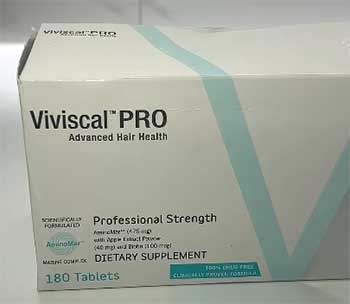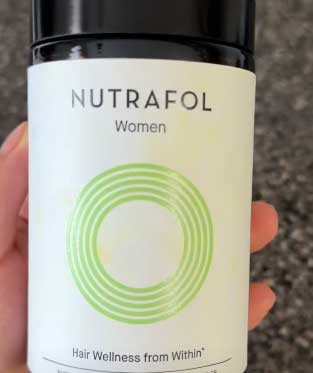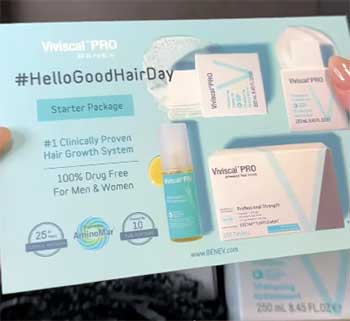I’ve been wrestling with thinning hair for years, and it’s a battle that chips away at confidence. After endless research, I narrowed my focus to two heavyweights in the hair regrowth arena: Viviscal Pro and Nutrafol.
This article is my firsthand exploration of these supplements, weighing their pros, cons, and key features to help you decide which might work for your hair goals.
With a conversational tone and an analytical lens, I’ll break down ingredients, costs, and user experiences, ensuring you have a clear path forward.
A Brief Comparison Table
| Feature | Viviscal Pro | Nutrafol |
| Primary Ingredients | AminoMar C, Biotin, Vitamin C, Iron | Ashwagandha, Saw Palmetto, Marine Collagen, Curcumin |
| Daily Dosage | 2 tablets | 4 capsules |
| Target Audience | Men and women with thinning hair | Men, women, postpartum, and menopausal women |
| Price (Monthly) | ~$40–$50 | ~$79–$88 |
| Allergen Info | Contains fish/shellfish | Free from shellfish, gluten, soy |
| Vegan-Friendly | No | Vegan option available |
| Clinical Studies | Over 25 years of research | Multiple published studies |
| Time to Results | 3–6 months | 3–6 months |
| Money-Back Guarantee | 90 days | 30 days |
My Hair Loss Story And Why I Chose These Products?

Hair loss sneaks up on you.
For me, it started with a few extra strands in the shower drain, then a noticeably wider part.
Stress, genetics, and maybe a lackluster diet were likely culprits, but I wasn’t ready to accept a thinning scalp as my new normal.
I scoured forums, consulted dermatologists, and tested everything from shampoos to serums.
Prescription options like minoxidil felt daunting, so I turned to supplements, landing on Viviscal Pro and Nutrafol for their strong reputations and clinical backing.
Viviscal Pro, a professional-strength version of the classic Viviscal supplement, caught my eye with its marine-based AminoMar C complex and long-standing research.
Nutrafol, on the other hand, intrigued me with its holistic, adaptogen-heavy approach, targeting stress and hormones. Both promised thicker, fuller hair, but which would deliver for me—and for you?
Let’s break it down.
Understanding Viviscal Pro
Viviscal Pro is the beefed-up sibling of Viviscal Extra Strength, designed for those serious about tackling hair loss. Its star player is AminoMar C, a proprietary marine complex derived from shark cartilage and mollusk powder.
Sounds intense, right?
This blend, combined with biotin, vitamin C, iron, and horsetail extract, aims to nourish hair follicles and extend the hair growth phase (anagen). I was drawn to its 25+ years of clinical research, with studies showing reduced shedding and increased hair thickness after 3–6 months.
Taking two tablets daily was simple enough, and I appreciated the affordability—around $40–$50 a month. But the fishy aftertaste? Not my favorite. I also had to consider my diet, as Viviscal Pro isn’t vegan and contains shellfish, a no-go for those with allergies.
Still, the transparency of its ingredient quantities gave me confidence I was getting a consistent dose.
Pros of Viviscal Pro
- Proven Track Record: Over 25 years of research and clinical trials back its effectiveness, with studies showing significant hair growth in women with thinning hair.
- Affordable: At $40–$50 monthly, it’s easier on the wallet than many competitors.
- Transparent Dosing: Unlike some supplements hiding behind proprietary blends, Viviscal Pro lists exact ingredient amounts.
- Simple Regimen: Two tablets a day fit seamlessly into my routine.
- Dermatologist-Endorsed: Many dermatologists recommend Viviscal Pro for its clinical efficacy.
Cons of Viviscal Pro
- Shellfish Allergens: The marine-based AminoMar C makes it unsuitable for those with fish or shellfish allergies.
- Not Vegan: The fish-derived ingredients rule it out for plant-based diets.
- Mild Side Effects: Some users, including me, noticed a fishy aftertaste or mild nausea.
- Limited Scope: It focuses heavily on marine proteins and vitamins, potentially missing broader causes like stress or hormones.
- Slower Results: Patience is key—expect 3–6 months for noticeable changes.
Exploring Nutrafol

Nutrafol takes a different approach, billing itself as a nutraceutical rather than a mere supplement.
Its formula is a powerhouse of botanicals, vitamins, and minerals, including ashwagandha, saw palmetto, marine collagen, and curcumin.
These target root causes of hair loss like stress, hormonal imbalances, and inflammation.
I was impressed by its tailored options: Women, Men, Postpartum, and Women’s Balance for menopausal women.
The vegan version was a nice touch for inclusivity.
At four capsules daily, Nutrafol’s regimen felt more involved, and the price tag—$79–$88 monthly—made me wince. Still, its clinical studies, like a 2018 trial showing improved hair growth in women, gave me hope.
I also liked that it’s free from common allergens like shellfish and gluten, making it safer for a broader audience. But the proprietary blends left me guessing about exact ingredient doses.
Pros of Nutrafol
- Holistic Approach: Targets stress, hormones, and nutrition, addressing multiple hair loss triggers.
- Tailored Formulas: Options for specific demographics (men, women, postpartum) increase personalization.
- Allergen-Free: No shellfish, gluten, or soy, and a vegan option broadens accessibility.
- Clinical Backing: Studies, like one in the Journal of Drugs in Dermatology, show reduced shedding and thicker hair.
- Additional Benefits: Users report stronger nails and better energy, which I noticed after a month.
Cons of Nutrafol
- High Cost: At $79–$88 monthly, it’s a significant investment.
- Proprietary Blends: Exact doses of key ingredients like ashwagandha are unclear.
- Four Capsules Daily: The dosage felt cumbersome compared to Viviscal Pro’s two tablets.
- Mild Digestive Issues: Some users, including me, experienced slight stomach upset initially.
- Shorter Guarantee: Only a 30-day money-back period versus Viviscal Pro’s 90 days.
Ingredients Face-Off Between Viviscal Pro And Nutrafol

Let’s get into the meat of what makes these products tick: their ingredients.
Viviscal Pro leans on AminoMar C, a marine complex studied for its ability to nourish hair follicles.
Biotin, vitamin C, and iron support overall hair health, while horsetail extract provides silica for strength.
These are solid, but the formula feels focused on nutrient deficiencies rather than broader issues like stress or DHT (a hormone linked to hair loss).
Nutrafol, by contrast, casts a wider net. Ashwagandha reduces cortisol, a stress hormone that can trigger shedding. Saw palmetto blocks DHT, a key player in androgenetic alopecia.
Marine collagen and curcumin add anti-inflammatory and structural support. I found Nutrafol’s blend more comprehensive, but the lack of exact dosing frustrated my inner skeptic. If I’m paying premium prices, I want to know how much of each ingredient I’m getting.
Both include horsetail extract, which inhibits 5α-reductase and supports hair strength. Viviscal Pro’s edge is its transparency, while Nutrafol’s strength lies in its adaptogenic and hormonal focus.
If stress or hormones drive your hair loss, Nutrafol might resonate more. If you suspect nutrient gaps, Viviscal Pro could be your pick.
My Experience With Viviscal Pro
I started Viviscal Pro with cautious optimism. The tablets were easy to swallow, though the faint fishy aftertaste lingered. After three months, I noticed less hair in my brush—a small but encouraging win.
By month five, my part looked slightly fuller, and my hair felt stronger. I didn’t experience major side effects, just occasional mild nausea if I took it on an empty stomach.
What I loved was the price and simplicity. At $40 a month, it didn’t break the bank, and two tablets daily were manageable.
But I wondered if I was missing out on addressing stress-related shedding, a big factor for me. The shellfish content also meant I had to warn friends with allergies when recommending it.
My Experience With Nutrafol

Switching to Nutrafol felt like upgrading to a luxury model.
The four capsules were a hassle, and my wallet groaned at $88 a month.
But after a month, I noticed not just less shedding but shinier hair and stronger nails—a bonus I didn’t expect.
By month four, my hairline looked denser, and I felt more energized, possibly from the adaptogens.
The downside?
Those proprietary blends nagged at me.
Was I getting enough ashwagandha to make a difference? Mild stomach upset in the first week was another hiccup, though it faded. Nutrafol’s holistic approach aligned with my stress-driven hair loss, but the cost and dosage were constant reminders of the commitment.
Cost and Accessibility
Money talks, and these supplements speak different languages. Viviscal Pro, at $40–$50 monthly, is budget-friendly and widely available at retailers like Amazon, Ulta, and Viviscal’s website. Discounts on bulk purchases or subscriptions sweeten the deal.
Nutrafol, at $79–$88, feels like a splurge, though autoship programs drop it to $79. It’s sold on Nutrafol’s site, Amazon, and select retailers, but the higher price demands a longer-term commitment.
Viviscal Pro’s 90-day money-back guarantee gave me peace of mind; Nutrafol’s 30-day window felt stingy. If you’re testing the waters, Viviscal Pro’s lower cost and longer return period make it less risky.
But Nutrafol’s premium ingredients might justify the expense if you see results.
Clinical Evidence and Dermatologist Opinions
Both products boast clinical studies, but their scope differs. Viviscal Pro’s research spans over 25 years, with trials showing reduced shedding and increased hair count in women.
A 2012 study highlighted AminoMar C’s role in promoting growth, though results were stronger in those with nutrient deficiencies. Dermatologists often recommend Viviscal Pro for its established efficacy.
Nutrafol’s studies, like a 2018 trial, demonstrate improved hair growth and thickness in women after six months. Its adaptogenic focus earns praise from dermatologists for addressing stress-related hair loss, though some critique the proprietary blends.
In a 2023 meta-analysis, Nutrafol showed modest efficacy in women (7.32 TH/cm² vs. placebo), while Viviscal performed better in men (13.23 TH/cm²).
User Feedback and Real-World Results
I dug into user reviews to see how others fared. Viviscal Pro users often raved about reduced shedding within three months, with some seeing baby hairs by month six.
Complaints centered on the fishy taste or nausea, and those with shellfish allergies were understandably frustrated. Nutrafol users reported thicker hair and better energy, but many balked at the price and four-capsule regimen.
Some mentioned no results after months, raising questions about consistency or underlying causes.
My experience mirrored these trends: Viviscal Pro was a steady, affordable performer, while Nutrafol felt more transformative but demanded patience and a bigger budget. Your results will depend on your hair loss triggers, consistency, and lifestyle factors like diet and stress management.
Which Is Right for You?
Choosing between Viviscal Pro and Nutrafol hinges on your needs and priorities. If you’re budget-conscious, prefer a simple regimen, or suspect nutrient deficiencies, Viviscal Pro is a solid bet.
Its long research history and dermatologist backing make it a safe choice, but shellfish allergies or vegan diets are dealbreakers. If stress, hormones, or a holistic approach drives your decision, Nutrafol’s tailored formulas and adaptogens might be worth the splurge.
Just be ready for the cost and capsule count.
I leaned toward Nutrafol for its broader approach, but Viviscal Pro’s affordability kept it in the running. Consider your lifestyle, budget, and hair loss causes. Consulting a dermatologist can also clarify which aligns with your health profile.
Combining With Other Treatments
Both supplements shine as standalone options, but pairing them with other treatments can boost results. Topical minoxidil, recommended by my dermatologist, complemented Viviscal Pro’s nutrient focus.
Low-level laser therapy or platelet-rich plasma (PRP) could enhance Nutrafol’s holistic benefits. I also improved my diet, adding zinc-rich foods and omega-3s, which amplified both products’ effects. Consistency is crucial—whether you choose one or combine treatments, stick with it for at least 3–6 months.
Frequently Asked Questions (FAQ)
No single product is universally “most successful.” Viviscal Pro and Nutrafol both show results, but minoxidil and finasteride have stronger clinical evidence. Your success depends on the cause of your hair loss and consistency.
Viviscal Pro has a higher potency and is formulated for advanced hair health, making it stronger than standard Viviscal. It’s ideal for severe thinning but costs more.
Mild nausea, fishy aftertaste, or stomach upset are reported. Those with shellfish allergies may experience reactions. Consult a doctor if concerns arise.
Many dermatologists praise Nutrafol for its holistic approach and clinical studies, especially for stress-related hair loss. Some criticize its proprietary blends and high cost.
Conclusion: Your Path To Thicker Hair
After months of testing Viviscal Pro and Nutrafol, I’ve learned there’s no one-size-fits-all fix for hair loss.
Viviscal Pro’s affordability and proven formula make it a reliable choice for nutrient-driven thinning, while Nutrafol’s comprehensive approach suits those battling stress or hormones.
You’ll need patience—3–6 months minimum—and a commitment to consistency. Weigh your budget, lifestyle, and hair loss triggers to choose what’s right for you. I’m rooting for you to find the solution that brings back your confidence and a fuller head of hair.
